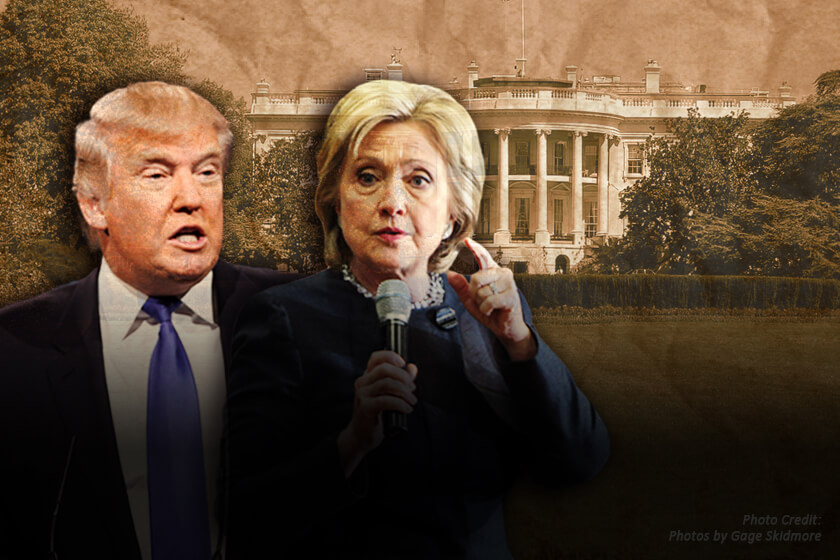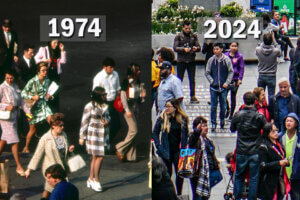West Long Branch, NJ – In a head-to-head contest for president, Hillary Clinton leads Donald Trump by 7 points among registered voters and by 8 points among likely voters. The Democrat’s lead shrinks by a point when potential third party support is taken into account. Both major party nominees remain unpopular, but more voters say it is important to keep Trump rather than Clinton out of the White House. The latest Monmouth University Poll also finds that attitudes towards terrorism and the Republican nominee’s proposed Muslim ban have not changed much since the Orlando tragedy.
Currently, Clinton holds a 7 point lead in a direct match-up against Trump – 47% to 40% among registered voters nationally. Among those who are likely to cast ballots in November, the Democrat’s edge expands to 49%-41%. Importantly, Clinton holds a 47% to 39% lead in the all-important swing states – ten states where the winning margin in the 2012 election was less than seven points.
Clinton has the support of 87% of Democrats and Trump has the support of 84% of Republicans, while independents split 42% for Clinton and 37% for Trump. The gender gap is particularly large, Clinton leads among women by 27 points (57%-30%) while Trump leads among men by 13 points (50%-37%). Clinton also holds a commanding advantage among black, Hispanic and Asian voters (72%-17%), while Trump leads among white voters (49%-38%).
When Libertarian nominee Gary Johnson and leading Green Party candidate Jill Stein are added to the mix, Clinton’s lead shrinks slightly to 6 points among registered voters – 42% to 36% for Trump, with Johnson earning 9% and Stein getting 4%. Clinton leads Trump by 7 points – 44% to 37% – among likely voters in this four-way contest.
“Clinton has the advantage as the general election campaign kicks off, particularly in key swing states. However, all signs point to 2016 turning out the most polarized electorate in memory,” said Patrick Murray, director of the independent Monmouth University Polling Institute.
Neither major party candidate is particularly popular. Clinton earns a negative 36% favorable and 52% unfavorable rating while Trump holds an even worse 28% favorable and 57% unfavorable rating. These results are largely unchanged from a Monmouth University Poll taken in March. Nearly half of all voters (49%) say it is very important to them to make sure Trump is not elected president, compared to 31% who say this is not at all important. Relatively fewer voters (41%) say it is very important to keep Clinton out of the White House compared to 35% who say this concern is not at all important to them. Among voters who are undecided or currently prefer a third party candidate, 48% say it is very important to them to prevent a Trump victory while just 32% say the same about Clinton.
“About one in seven voters would like to cast their ballot for a third party candidate. The fear of either Clinton or Trump getting into the White House, though, may lead some to hold their noses and vote for the other major party nominee. And right now, a Trump victory appears to be the more troubling outcome for these voters,” said Murray.
On the issues, slightly more voters see Clinton (47%) as better able than Trump (44%) to deal with the economy and jobs. Her issue advantage is similarly narrow on handling the threat of terrorism on U.S. soil – 46% prefer Clinton and 44% prefer Trump.
With the shooting in Orlando fresh on voters’ minds, just 29% say the U.S. government is doing enough to prevent future domestic terrorist attacks while 64% say it is not doing enough. These results are largely unchanged from a Monmouth poll taken shortly after the San Bernardino shooting last year (31% doing enough and 62% not doing enough in December 2015).
Most voters (52%) say that U.S. citizens who become radicalized pose a bigger threat than overseas terrorists who infiltrate the country (29%). This opinion has shifted by just a few points since December, when 48% pointed to homegrown terrorism as the bigger threat while 36% were more worried about overseas terrorists.
Currently, 21% of voters support and 70% oppose a ban on all Muslims entering the U.S., which Trump first proposed after the San Bernardino attack. Opinion on this proposal back then was a similar 27% support and 65% oppose.
Since Orlando, Trump has also suggested a blanket immigration ban against any person living in a country where there has been a history of terrorism against the West. Voters reject this proposal as well, with just 34% in favor compared to 57% who are opposed.
Turning to the issue of gun control, voters are more likely to back a ban on the sale of assault weapons like the kind used in the Orlando shooting, with 52% supporting such a ban and 43% opposing it.
The Monmouth University Poll was conducted by telephone from June 15 to 19, 2016 with 803 registered voters in the United States. The results in this release have a margin of error of ± 3.5 percent. The poll was conducted by the Monmouth University Polling Institute in West Long Branch, NJ.
DATA TABLES
The questions referred to in this release are as follows:
(* Some columns may not add to 100% due to rounding.)
1. If the election for President was today, would you vote for Donald Trump the Republican or Hillary Clinton the Democrat? [NAMES WERE ROTATED]
| TREND Registered voters | June 2016 | March 2016 |
| Donald Trump | 40% | 38% |
| Hillary Clinton | 47% | 48% |
| (VOL) Other candidate | 5% | 2% |
| (VOL) Undecided | 6% | 3% |
| (VOL) No one/refused | 2% | 9% |
| Unwtd N |
803 |
848 |
2. And who would you vote for if the candidates were Donald Trump the Republican, Hillary Clinton the Democrat, Gary Johnson the Libertarian, or Jill Stein of the Green Party? [NAMES WERE ROTATED]
| TREND Registered voters | June 2016 | March 2016 |
| Donald Trump | 36% | 34% |
| Hillary Clinton | 42% | 42% |
| Gary Johnson | 9% | 11% |
| Jill Stein | 4% |
n/a |
| (VOL) Other candidate | 2% | 1% |
| (VOL) Undecided | 4% | 5% |
| (VOL) No one/refused | 1% | 7% |
| Unwtd N |
803 |
848 |
3. Are you certain about your vote choice, or might you change your mind before Election Day?
| June 2016 | |
| Certain | 69% |
| Might change mind | 18% |
| Undecided on vote | 13% |
| Unwtd N |
803 |
Regardless of who you may support for president…
[QUESTIONS 4 & 5 WERE ROTATED]
4. How important is it to you to make sure that Donald Trump does NOT get elected president – very important, somewhat important, not too important, or not at all important?
| June 2016 | |
| Very important | 49% |
| Somewhat important | 10% |
| Not too important | 8% |
| Not at all important | 31% |
| (VOL) Don’t know | 2% |
| Unwtd N |
803 |
5. How important is it to you to make sure that Hillary Clinton does NOT get elected president – very important, somewhat important, not too important, or not at all important?
| June 2016 | |
| Very important | 41% |
| Somewhat important | 10% |
| Not too important | 11% |
| Not at all important | 35% |
| (VOL) Don’t know | 3% |
| Unwtd N | 803 |
[QUESTIONS 6 & 7 WERE ROTATED]
6. Is your general impression of Donald Trump favorable or unfavorable, or do you have no opinion of him?
| TREND Registered voters | June 2016 | March 2016 | Oct. 2015 | Aug. 2015 | June 2015 |
| Favorable | 28% | 30% | 32% | 31% | 18% |
| Unfavorable | 57% | 60% | 50% | 54% | 57% |
| No opinion | 15% | 11% | 18% | 14% | 25% |
| Unwtd N | 803 | 848 | 836 | 1,033 | 829 |
7. Is your general impression of Hillary Clinton favorable or unfavorable, or do you have no opinion of her?
| TREND Registered voters | June 2016 | March 2016 | Oct. 2015 | Aug. 2015 | June 2015 |
| Favorable | 36% | 40% | 41% | 38% | 41% |
| Unfavorable | 52% | 51% | 48% | 48% | 44% |
| No opinion | 13% | 9% | 11% | 14% | 14% |
| Unwtd N | 803 | 848 | 836 | 1,033 | 829 |
[QUESTIONS 8 & 9 WERE ROTATED]
8. Who do you trust more to handle the economy and jobs – Donald Trump or Hillary Clinton? [NAMES WERE ROTATED]
| June 2016 | |
| Trump | 44% |
| Clinton | 47% |
| (VOL) Neither | 6% |
| (VOL) Don’t know | 3% |
| Unwtd N | 803 |
9. Who do you trust more to handle the threat of terrorism on U.S. soil – Donald Trump or Hillary Clinton? [NAMES WERE ROTATED]
| June 2016 | |
| Trump | 44% |
| Clinton | 46% |
| (VOL) Neither | 7% |
| (VOL) Don’t know | 3% |
| Unwtd N | 803 |
10. Do you think the U.S. government is doing enough or not doing enough to prevent a future terrorist attack on American soil?
| TREND Registered voters | June 2016 | Dec. 2015 | Jan. 2015 |
| Doing enough | 29% | 31% | 44% |
| Not doing enough | 64% | 62% | 50% |
| (VOL) Doing too much | 0% | 0% | 1% |
| (VOL) Don’t know | 6% | 7% | 5% |
| Unwtd N | 803 | 856 | 863 |
11. Which do you think poses a bigger threat of future attacks on U.S. soil – terrorists from overseas who infiltrate the country or U.S. citizens who become radicalized? [OPTIONS WERE ROTATED]
| TREND Registered voters | June 2016 | Dec. 2015 |
| Terrorists from overseas | 29% | 36% |
| Radicalized U.S. citizens | 52% | 48% |
| (VOL) Both equally | 14% | 11% |
| (VOL) Don’t know | 5% | 4% |
| Unwtd N | 803 | 856 |
[QUESTIONS 12 THROUGH 14 WERE ROTATED]
12. Do you support or oppose banning all Muslims from entering the U.S.?
| TREND Registered voters | June 2016 | Dec. 2015 |
| Support | 21% | 27% |
| Oppose | 70% | 65% |
| (VOL) Depends | 6% | 5% |
| (VOL) Don’t know | 3% | 3% |
| Unwtd N | 803 | 856 |
13. Do you support or oppose a blanket ban on the immigration of any person who lives in a country where there has been a history of terrorism against the west?
| June 2016 | |
| Support | 34% |
| Oppose | 57% |
| (VOL) Depends | 5% |
| (VOL) Don’t know | 5% |
| Unwtd N | 803 |
14. Do you support or oppose banning the sale of assault weapons like the kind used in the Orlando shooting?
| June 2016 | |
| Support | 52% |
| Oppose | 43% |
| (VOL) Depends | 3% |
| (VOL) Don’t know | 3% |
| Unwtd N | 803 |
[Q15-18 held for future release.]
* 2012 Presidential Election Regions
Swing States (<7% margin): CO, FL, IA, NV, NH, NC, OH, PA, VA, WI
Leaning States (7-12% margin): AZ, GA, IN, MI, MN, MS, MO, NM, OR, SC
Red States (>12% GOP margin): AL, AK, AR, ID, KS, KY, LA, MT, NE, ND, OK, SD, TN, TX, UT, WV, WY
Blue States (>12% Dem margin): CA, CT, DC, DE, HI, IL, ME, MD, MA, NJ, NY, RI, VT, WA
The Monmouth University Poll was sponsored and conducted by the Monmouth University Polling Institute from June 15 to 19, 2016 with a national random sample of 803 registered voters, drawn from both a list of registered voters and through random digit dialing. The interview was conducted by a live caller in English, including 401 contacted on a landline telephone and 402 contacted on a cell phone. Monmouth is responsible for all aspects of the survey design, data weighting and analysis. The final sample is weighted for region, age, education, gender and race based on national voter list information and U.S. Census data. Data collection support provided by Braun Research (field), SSI (RDD sample) and Aristotle (voter list sample). For results based on this sample, one can say with 95% confidence that the error attributable to sampling has a maximum margin of plus or minus 3.5 percentage points (unadjusted for sample design). Sampling error can be larger for sub-groups (see table below). In addition to sampling error, one should bear in mind that question wording and practical difficulties in conducting surveys can introduce error or bias into the findings of opinion polls.
| DEMOGRAPHICS (weighted) |
| 28% Rep |
| 38% Ind |
| 34% Dem |
| 47% Male |
| 53% Female |
| 25% 18-34 |
| 26% 35-49 |
| 28% 50-64 |
| 21% 65+ |
| 71% White |
| 13% Black |
| 10% Hispanic |
5% Asian/Other |
Click on pdf file link below for full methodology and results by key demographic groups.




